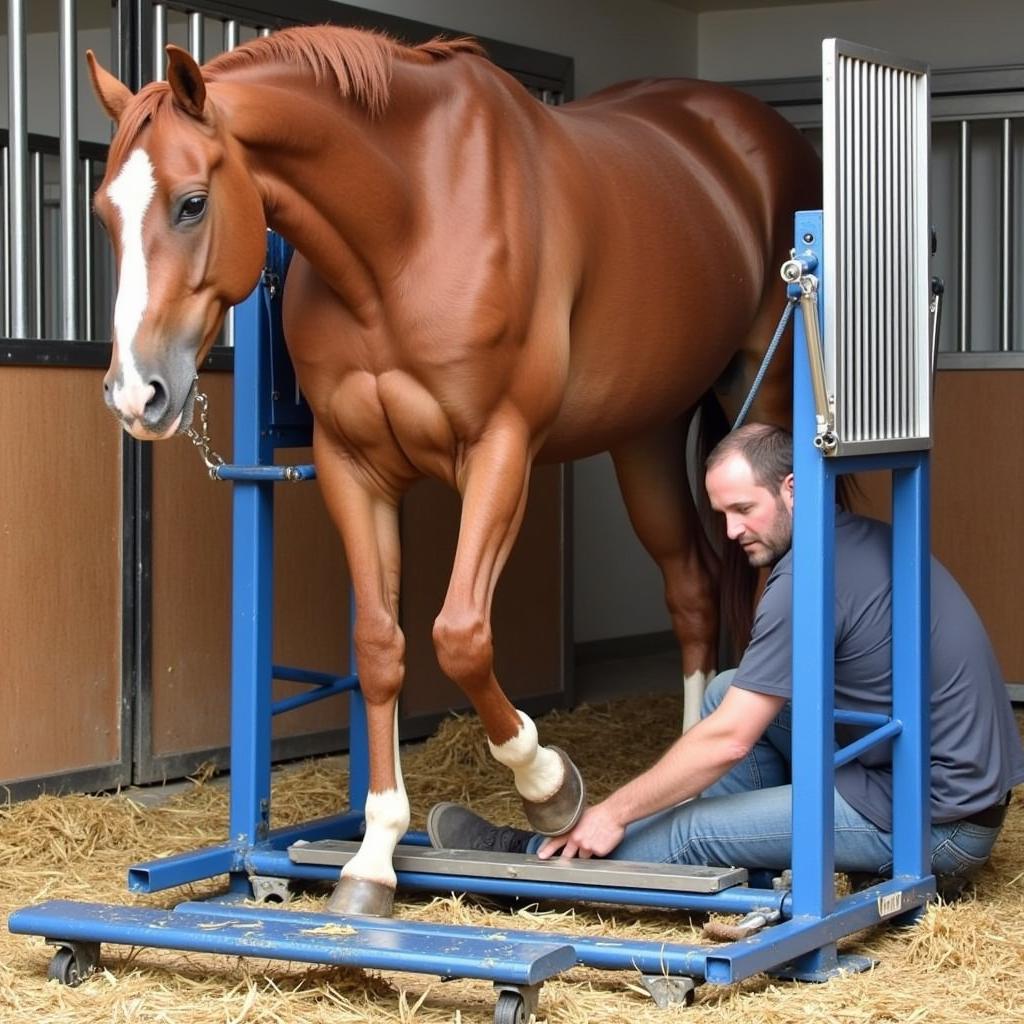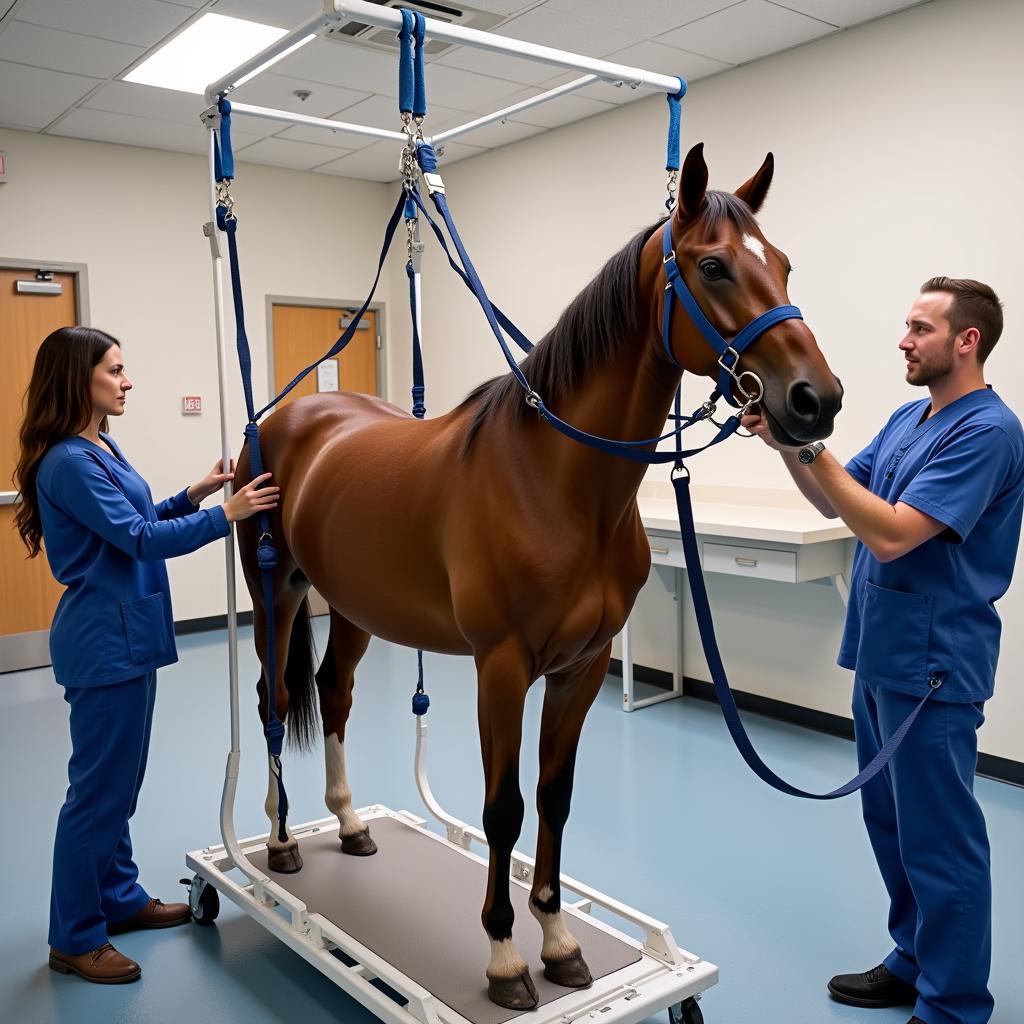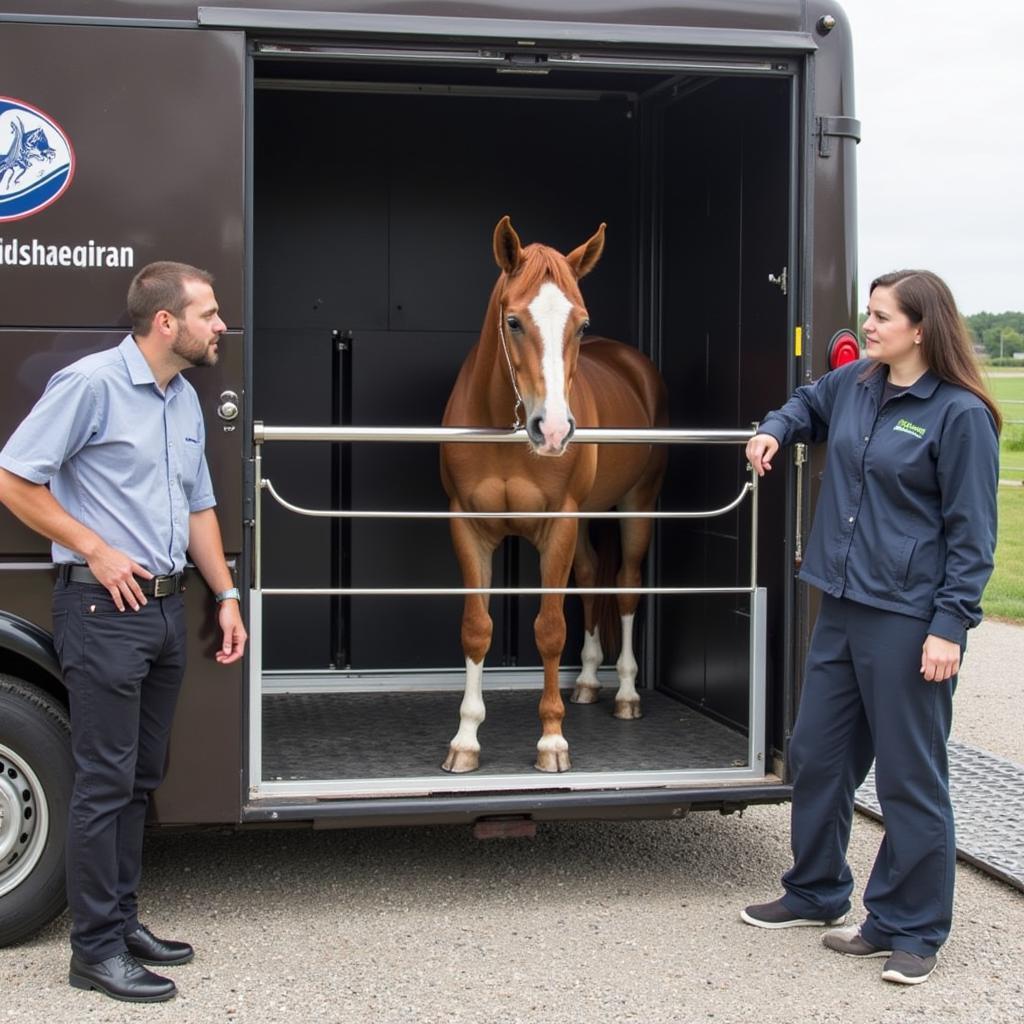A Horse Lift, also known as an equine lift, is a specialized piece of equipment designed to provide support and assistance to horses in various situations. From routine hoof care to aiding horses with mobility issues, a horse lift plays a vital role in equine management and well-being.
 Horse lift being used to assist a farrier
Horse lift being used to assist a farrier
Types of Horse Lifts and Their Uses
Horse lifts come in various designs, each tailored to specific needs:
1. Sling Lifts
Sling lifts are commonly used by veterinarians and equine rehabilitation centers. These lifts gently cradle the horse’s body in a sturdy sling, providing support and allowing for safe lifting and movement. Sling lifts are particularly beneficial for:
- Recovering from Surgery or Injury: Providing crucial support during recovery, minimizing strain on healing tissues.
- Assisting with Recumbent Horses: Helping to reposition and move horses unable to stand on their own.
- Facilitating Medical Procedures: Providing a stable platform for examinations, treatments, or X-rays.
 An equine sling lift being used in a veterinary setting
An equine sling lift being used in a veterinary setting
2. Hoist Lifts
Hoist lifts use a system of straps and a motorized hoist to raise and lower the horse. While similar to sling lifts, hoist lifts are often used for:
- Short-Term Support: Assisting horses that need temporary help standing or balancing.
- Facilitating Farrier Work: Lifting specific legs for extended periods, aiding in hoof care.
- Supporting Horses with Neurological Conditions: Providing stability for horses with balance issues.
3. Mobile Lifts
As the name suggests, mobile lifts offer portability, making them ideal for:
- Emergency Situations: Extracting a horse from a difficult location, such as a ditch or trailer.
- Transporting Injured Horses: Safely moving an injured horse to a veterinary facility.
- Providing Temporary Support at Events: Assisting horses that may need help standing or loading after competitions.
Benefits of Using a Horse Lift
Investing in a horse lift offers numerous benefits:
- Improved Safety: For both the horse and handler, minimizing the risk of injury during lifting or handling.
- Reduced Stress: Providing a secure and controlled environment, reducing anxiety for horses requiring assistance.
- Enhanced Medical Care: Facilitating examinations, treatments, and recovery procedures, leading to better outcomes.
- Increased Longevity: Supporting horses with mobility issues, allowing them to maintain a good quality of life.
Choosing the Right Horse Lift
Selecting the appropriate horse lift depends on several factors:
- Horse’s Size and Weight: Ensuring the lift has adequate weight capacity and appropriate sling or harness size.
- Intended Use: Matching the lift’s design and functionality to the specific tasks it will be used for.
- Budget and Features: Considering additional features like emergency lowering systems, adjustable legs, and ease of use.
 Horse owner and veterinarian discussing a horse lift
Horse owner and veterinarian discussing a horse lift
“When choosing a horse lift, prioritize safety and functionality,” advises Dr. Emily Carter, DVM, specializing in equine sports medicine. “A well-designed lift should provide secure support for the horse while allowing for ease of use and adjustments by the handler.”
Conclusion
A horse lift is a valuable tool for any horse owner, offering a safe and effective way to provide support and assistance to horses in need. Whether for routine care, medical treatments, or emergency situations, a horse lift can significantly contribute to a horse’s well-being and longevity. By understanding the different types of lifts available and their specific applications, horse owners can make informed decisions to ensure the safety and comfort of their equine companions.
FAQs about Horse Lifts
1. How much weight can a horse lift typically support?
Horse lifts are designed to handle a wide range of weights, with many models capable of lifting over 2,000 pounds.
2. Are horse lifts difficult to use?
Most horse lifts are designed for user-friendliness, with intuitive controls and safety features. However, proper training and familiarization with the equipment are crucial before operating a horse lift.
3. Do I need special training to operate a horse lift?
While specialized training is not always mandatory, seeking guidance from experienced handlers or veterinarians is highly recommended. They can provide valuable insights into safe operation and handling techniques.
4. Where can I purchase a horse lift?
Horse lifts can be purchased from equine equipment suppliers, veterinary supply stores, and specialized online retailers.
5. Are there financing options available for horse lifts?
Yes, many suppliers offer financing options or rental programs to make horse lifts more accessible to horse owners.
Do you have other questions or need further assistance with horse care?
Explore more helpful articles on our website:
For personalized guidance and support, contact our dedicated team at Justus Horses USA. Call us at 0772127271, email us at [email protected], or visit us at QGM2+WX2, Vị Trung, Vị Thuỷ, Hậu Giang, Việt Nam. Our knowledgeable staff is available 24/7 to answer your questions and provide expert advice on all your horse care needs.